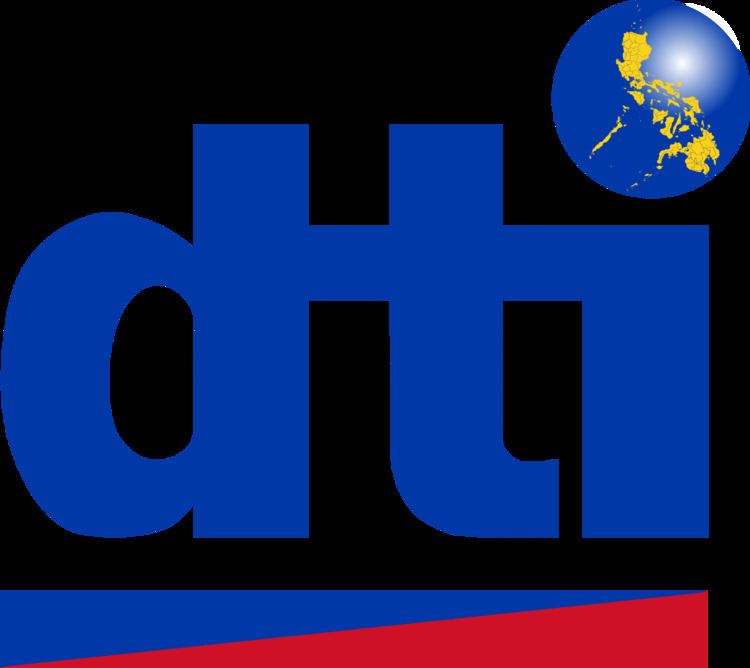Formed September 6, 1901 | Annual budget ₱3.7 billion (2015) | |
 | ||
Headquarters Trade and Industry Building, 361 Gil Puyat Avenue, Bel-Air, Makati, Philippines Department executive Ramon M. Lopez, Secretary Website www.dti.gov.ph www.business.gov.ph Similar Securities and Exchange Commission (Philippines), Bureau of Internal Revenue (Philippines), Department of Labor and Employment (Philippines) | ||
The Philippine Department of Trade and Industry (Filipino: Kagawaran ng Kalakalan at Industriya, abbreviated as DTI) is the executive department of the Philippine Government tasked to expand Philippine trade, industries and investments as the means to generate jobs and raise incomes for Filipinos. It acts as catalyst for intensified private sector activity in order to accelerate and sustain economic growth through comprehensive industrial growth strategy, progressive and socially responsible trade liberalization and deregulation programs and policymaking designed for the expansion and diversification of Philippine trade - both domestic and foreign.
Contents
The national organizational set up of the department include Industry Promotion Group (IPG), Industry Development Group (IDG), Consumer Protection Group (CPG), Regional Operations Group (ROG), and the Management Services Group (MSG). Its hierarchical organization include 33 foreign trade service posts, 16 regional offices, 81 provincial/city/area offices, 13 bureaus, 7 attached agencies, 7 attached corporations, and 10 service offices.
The department is headed by a Secretary (equivalent to Minister) and assisted by Undersecretaries (equivalent to Deputy Minister) which take charge of certain sub-department each, and Assistant Secretaries which serve as specialized assistants of the Secretary.
Department of Commerce and Police
On September 6, 1901, the Philippine Commission established the Department of Commerce (and Police) of the Insular Government. William Cameron Forbes future Governor-General of the Philippines served as its commissioner from 1904 through 1908.
Department of Commerce and Industry (DCI)
After World War II, President Manuel Roxas issued Executive Order (EO) No. 94 on October 4, 1947 creating the Department of Commerce and Industry (DCI). Cornelio Balmaceda, a much sought-after professor of economics and director of the Bureau of Commerce (BOC), was appointed acting secretary of the newly created Department of Commerce and Industry.
Prior to EO 94, the Bureau of Commerce was tasked to develop and promote the country's trade and industry, under the overall supervision of the Department of Agriculture and Commerce, as stipulated by Act 4007 by the Philippine Legislature, enacted on December 5, 1932.
By 1972, the DCI had grown into a big organization with 10 regular bureaus and 22 agencies under its direct supervision. The DCI was mandated to promote, develop, expand, regulate and control of foreign and domestic trade and industry, as well as tourism.
To have closer supervision and to ensure more effective delivery of services, President Ferdinand E. Marcos issued Presidential Decree (PD) 189 on May 11, 1973 creating the Department of Tourism to handle all tourism-related matters. A year later on June 21, 1974, Marcos issued PD 488 creating the Department of Industry whose principal function was to promote and enhance the growth of the country's existing and thriving industries.
On June 2, 1975, the Department of Trade was created under PD 721 to pursue efforts of the government toward strengthening the country's socio-economic development, particularly in the area of commercial activities. A key strategy of the new department was vigorous export promotion to generate much needed foreign exchange. A Bureau of Foreign Trade was also particularly established to push for domestic trade and marketing programs.
In the early 1980s, thi's goal of national economic development required the need to hew industrial promotion efforts with the expansion of Philippine trade overseas. This resulted in the creation of the Ministry of Trade and Industry (MOTI) on July 27, 1981, which took over the functions of the subsequently abolished Departments of Trade and of Industry.
Drastic changes followed after the 1986 EDSA Revolution. President Corazon Aquino signed Executive Order No. 133 on February 27, 1987 effectively reorganizing the Ministry of Trade and Industry and renaming it the Department of Trade and Industry (DTI). This was further strengthened by the issuance of Executive Order 292 (Administrative Code of 1987). Other latter legislations have also amended its functions and structures.
Attached Agencies
The following are attached agencies of the Department of Trade and Industry:
Attached agencies are actually sub-agencies of any national departments of the national government organization in the Philippines in which creation is established by special laws and its operation is independent of its mother unit. The mother unit only serves as supervisory on these special attached agencies.
